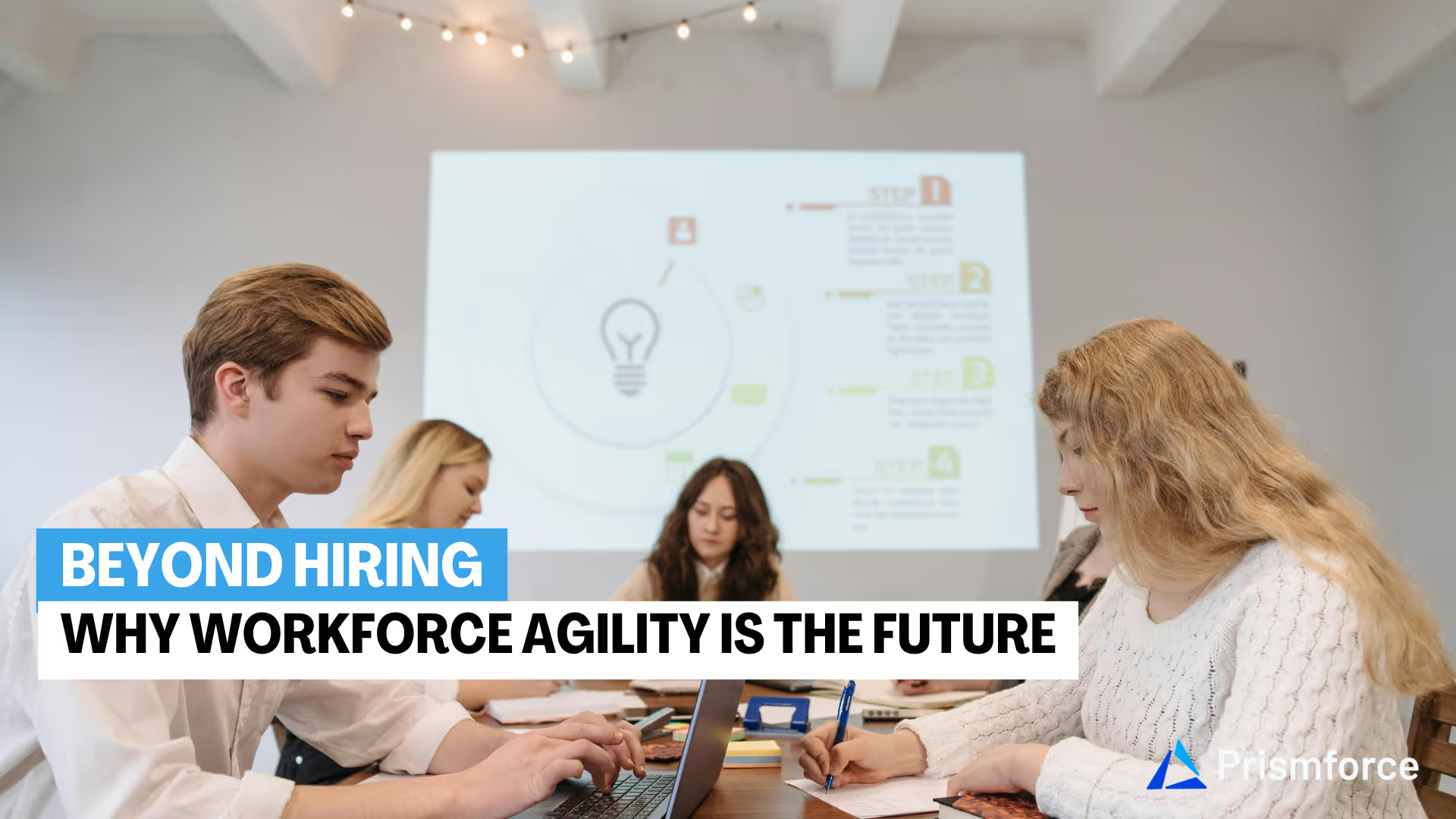
Enterprise technology initiatives are at a crossroads. Despite substantial investments and clear strategic visions, a staggering 75% of enterprise tech projects still fail, primarily because of rigid talent models that lack the flexibility to adapt swiftly to evolving business demands. In an era marked by relentless technological evolution, traditional hiring practices alone no longer suffice. The solution? Workforce agility.
Workforce agility transcends traditional hiring by cultivating a fluid talent strategy, one that aligns rapidly with shifting business priorities and technological advancements. Instead of relying on static teams with fixed skillsets, agile workforce management leverages skills intelligence to dynamically assemble and reassemble talent, ensuring the right skills are matched to the right challenges at precisely the right time.
Companies embracing workforce agility aren't just adapting faster; they're achieving higher rates of project success, reducing costly overruns, and gaining a critical competitive edge. In this article, we'll explore why workforce agility has become an essential strategy for enterprise tech services and how it can revolutionize your approach to talent.
What is Workforce Agility?
Workforce agility is the strategic capability of an organization to rapidly adapt and reconfigure its talent pool to respond effectively to shifting business requirements and market conditions. Rather than depending solely on permanent, rigid team structures, agile workforce management emphasizes flexibility, continuous skill development, and proactive talent mobility. This agility enables organizations to anticipate skill gaps, swiftly redeploy resources, and maintain productivity even amid disruption.
At its core, workforce agility leverages advanced skills intelligence platforms and real-time analytics to inform decision-making. By identifying existing skillsets, predicting future skill requirements, and facilitating rapid reskilling and upskilling, organizations can align their human capital directly with strategic objectives. Recent research highlights that companies implementing agile workforce strategies experience up to 30% increased productivity and significantly reduced time-to-market for critical projects.
In essence, workforce agility transforms talent management from a static, reactive process into a dynamic, proactive strategy, positioning companies to thrive in an increasingly complex and competitive landscape.
Why Workforce Agility is Non-Negotiable for Tech Services
Rapid Technological Change
Technology evolves at an unprecedented pace. For tech services, remaining competitive means rapidly adapting to emerging technologies, new platforms, and innovative practices. Workforce agility empowers organizations to quickly pivot their talent strategies, ensuring alignment with cutting-edge developments and minimizing the lag between innovation and implementation.
Addressing Skill Gaps Effectively
A persistent challenge in the tech industry is the widening skills gap. According to Gartner, 64% of IT executives identify talent shortages as the primary barrier to adopting emerging technologies. Workforce agility mitigates this challenge by proactively identifying skills gaps and enabling targeted reskilling, significantly reducing downtime and improving responsiveness.
Enhancing Competitive Advantage
Agile workforce management not only improves operational efficiency but also provides a sustainable competitive edge. Organizations that adopt workforce agility are better positioned to capitalize on new market opportunities, accelerate project delivery, and enhance overall client satisfaction. McKinsey found that agile organizations were nearly twice as likely to report market-leading financial performance compared to their non-agile counterparts.
Ultimately, workforce agility has moved from being an advantageous strategy to an essential capability for tech services. In an environment where adaptability dictates survival and success, agile talent management is no longer optional—it's a strategic imperative.
Building Workforce Agility: A Framework for Tech Leaders
Embrace Skills Intelligence
Adopting advanced skills intelligence platforms allows tech leaders to accurately map existing talent capabilities, identify emerging skill demands, and strategically fill skill gaps. Leveraging data-driven insights enables better forecasting and more agile responses to future workforce needs.
Cultivate Continuous Learning
Promoting a culture of continuous learning and development equips employees to rapidly acquire and apply new skills. Encouraging learning agility through personalized training programs and real-time feedback loops helps maintain workforce readiness and adaptability.
Foster Flexible Workforce Structures
Building flexible teams and utilizing contingent or gig talent alongside permanent employees enhances an organization's ability to swiftly scale talent up or down. Tech leaders must implement adaptive workforce planning frameworks to seamlessly integrate and manage diverse talent pools effectively.
Measuring Workforce Agility: Metrics That Matter
Time to Fill Skill Gaps
Monitoring the speed at which identified skill gaps are filled measures an organization’s agility in responding to talent needs.
Talent Mobility Rates
Assessing how frequently employees move across roles or projects provides insight into workforce flexibility and adaptability.
Employee Upskilling and Reskilling Rates
Tracking the percentage of employees actively engaging in upskilling or reskilling programs demonstrates a commitment to continuous learning and proactive talent management.
Project Delivery Speed
Evaluating how quickly projects are completed after assembling agile teams indicates workforce responsiveness.
Employee Engagement Scores
High engagement typically correlates with agile, dynamic workplaces that provide meaningful opportunities.
Workforce Utilization Rate
Analyzing the proportion of actively engaged talent helps determine efficient deployment and flexibility.
Future-Proofing Your Workforce
Future-proofing your workforce means proactively preparing your talent strategy to effectively navigate future disruptions, evolving technologies, and shifting market demands. It's about building a resilient, adaptive workforce capable of embracing continuous change. Here’s how you can future-proof your workforce:
Continuous Skill Monitoring
Regularly update your skill ontologies using advanced market intelligence to identify emerging skill trends and proactively manage your talent pipeline.
Personalized Learning Pathways
Implement personalized development plans and AI-driven learning paths tailored to individual employee needs, accelerating their ability to adapt and grow professionally.
Culture of Agility and Innovation
Foster a culture that encourages experimentation, innovation, and adaptability, allowing teams to quickly pivot and embrace new solutions when faced with unexpected challenges.
Strategic Workforce Planning
Adopt sophisticated forecasting tools and analytics to predict future skill needs and align workforce strategies accordingly, ensuring preparedness for future scenarios.
Organizations investing in these proactive strategies not only navigate disruptions effectively but also consistently outperform their peers in innovation, resilience, and long-term growth.
Build a Solid Workforce and Talent Pool with Prismforce
Workforce agility is not merely beneficial—it's crucial for survival and growth. Organizations that embrace agile talent management can swiftly adapt to technological changes, effectively address skill gaps, and sustain a competitive advantage. Leveraging advanced technology is essential to achieving these outcomes efficiently.
Prismforce, with its powerful AI-driven solutions, is uniquely positioned to help tech leaders build and sustain a highly agile workforce. The platform streamlines skills visibility, accelerates internal talent fulfillment, and significantly reduces talent deployment times. Organizations leveraging Prismforce experience tangible benefits such as:
- 4-5x increase in skills tagged per employee through AI-led automatic profiling
- 90%+ accuracy in skill identification for precise talent deployment
- 20% improvement in internal talent fulfillment rates
- 30% reduction in demand fulfillment time, ensuring quicker, more efficient project launches
By adopting Prismforce, tech organizations can effectively navigate the complexities of today's talent demands, positioning themselves for sustained success and future-ready agility.


.avif)
.avif)
